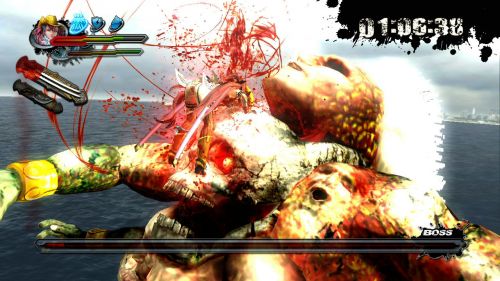

Welcome to the inaugural edition of our new monthly feature, Co-Op International! Here I’ll be discussing co-op games that have not been released in the US. This will include current gen games as well as classics. We hope you’ll enjoy learning more about Japanese games – please let us know in the comments section!
Onechanbara Z: Kagura is the sequel to 2009’s Onechanbara: Bikini Samurai Squad from developer Tamsoft and D3 publisher. With no US release announced, the Japanese version of Kagura is currently the only way to play this entry. While the previous game had its fans (including me), it took a lot of flak from reviewers for its many rough edges. Tamsoft may not have ironed out all of the wrinkles with Kagura, but it does look and feel much more at home on the Xbox 360 this time around.
Previous Onechanbara games involved bikini-clad heroines facing off against armies of zombies, mutants, and their human creators. This time the zombies are joined by a new threat: vampires. And who better to fight vampires than a couple of lady dhampirs (half human vampires)? The new protagonists are Kagura and Saaya; one dresses in a revealing swimsuit and cowboy hat, the other a school uniform. Their appearances are pandering, silly, and unquestionably part of the game’s charm. If you don’t get the appeal of half-naked ladies fighting monsters till they’re drenched in blood, then this series just isn’t for you (and maybe you should check yourself for a pulse).
Did I say drenched? Yes, like past games, the heroines become increasingly splattered with gore as they battle. Once fully coated, they enter Blood Rage mode and start dealing and receiving twice the damage for a set time. The life meter of a character in Blood Rage slowly dwindles, adding additional risk alongside the extra damage-dealing. Yet the life drain is far less imposing in Kagura because both heroines can use their vampire powers to heal at any time by pressing X and A simultaneously. Players can take advantage of Blood Rage to get tons of fast kills and heal as necessary.
Killing mindless hoards of bad guys is far more engaging in this sequel thanks to a much improved combat system. With two primary attack buttons (weak and strong) and lots of new moves and combos, the fighting no longer feels outdated. Both characters can switch between two primary weapons at any time: Double Swords or Dagger for Kagura and Chainsaw or armored Knuckles for Saaya. Each weapon has totally different abilities and moves, making for a total of four unique play styles. As before, players can usually switch between either girl at any time; the game doesn’t end until both run out of life.
While the fighting has improved exponentially from Bikini Samurai Squad, it’s still not perfect. The lock-on button performs erratically at best, often choosing a random target rather than the boss you’d actually want to focus on. Worse, this Onechanbara still inexplicably lacks a block button. I couldn’t even find an evade move like the last game had, so dodging can be tough. Later bosses will sometimes knock the player against a wall and just wail away with very little chance of escape. These problems don’t kill the fun but they can be annoying.
Kagura’s Story mode is shorter and tighter than previous games, consisting of just 16 stages (three of which are boss-only stages). While the number of levels has dropped, these show much more care in their design. Gone are the maze-like treads through dark and bland environments, replaced with smaller and more varied locations.

That variety extends to the bosses, too. They range from a screen-filling colossus to giant snakes and dragons. While most of these battles involve hacking away or firing projectiles as normal, at certain points the girls get to chop off the bosses’ limbs and even suck their blood. Those sequences play out via dramatic, awesomely bloody Quick Time Events. Thankfully the inputs are short and incredibly simple, making them almost impossible to fail.
Blood and babes aside, what really made Bikini Samurai Squad fun for me was its character development/grinding system. I just love games that let you replay past stages and also take on higher difficulties to build up your character. In Kagura, enemies drop yellow orbs which are much easier to collect than before since they automatically fly to the player now. These can be used to buy upgraded weapons, recovery items, new moves, and stat-altering rings. To get the very best rings, you’ll need to run through Story mode on higher difficulties and also take on Mission mode. Altogether, it’s a fairly addictive system.
That brings us to the co-op portion of the review. See, even though the last game supported campaign co-op, some stages forced the second player to sit out – a real buzz kill when playing with a friend. Tamsoft’s solution in the sequel: axe campaign co-op and create a separate Mission mode. Ditching the trappings of story, Mission mode’s 26 stages focus squarely on killing as many enemies as possible. Completing the whole thing (together or alone) unlocks a choice ring, while earning the highest rank on each stage (must be done solo) bestows the best ring in the game. Co-op Mission progress is separate from solo progress, but abilities and orbs earned carry over between all game modes.
Unfortunately for co-op fans, each player’s split-screen is a tiny 16:9 display ala Resident Evil 5. Presumably that style of split-screen is faster and easier for developers to implement, but what a waste of screen real estate. Interestingly, whenever either player initiates an amputation or finishing move on a boss, the game briefly switches to a single full-screen display of the bloodshed. The whole thing takes some adjustment, though it bothered my partner and me much less after a few levels. The co-op here may be nothing special, but it still adds some diversity to the grinding experience.
Cultural quirks: One look at the game’s cover reveals Onechanbara’s wacky Japanese sensibilities. Titular Kagura’s ludicrous and sexy outfit, stylish boss monster designs, and a completely serious storyline are all hallmarks of Asian development.
Chances of coming to the US: Good. While Bikini Samurai Squad didn’t receive rave reviews on this side of the pond, keep in mind that Onechanbara Z: Kagura is an Xbox 360 exclusive. The Japanese 360 market is incredibly tiny, so D3 Publisher could easily sell twice as many copies if they bring it to North America. As long as they release it here at a budget price as before, it should catch on with Japanophiles and fans of Dynasty Warriors-type games.
Language barrier: Medium. All story scenes are fully voiced in Japanese, though Kagura herself is fond of spouting poorly-pronounced English phrases just before boss battles. She’s got the heart of a champ! As a result, the story will be lost on non-Japanese speakers, but c’mon. You’re not missing much. We play these games for the hacking and/or slashing. At least the story scenes actually feature dynamic camera angles and animations this time instead of just talking heads.
Outside of the story, the main menu and options menu are in full English. Tutorial information, item names and descriptions, Quest descriptions, and Achievements all appear in Japanese text though, which could mask some of the game’s finer points from English speakers. Luckily my Achievement Guide translates pretty much everything you’d need to know.
Difficulty of importing: High. Like most Japanese Xbox 360 games, Onechanbara Z: Kagura is region-locked. That means it won’t play on US or European consoles. To play it, you’d need a Japanese or Asian console, which makes you either an import enthusiast or a hardcore Achievement hunter. Plus the game alone costs over $80 to import, so waiting for a probable US release is a much more affordable option.